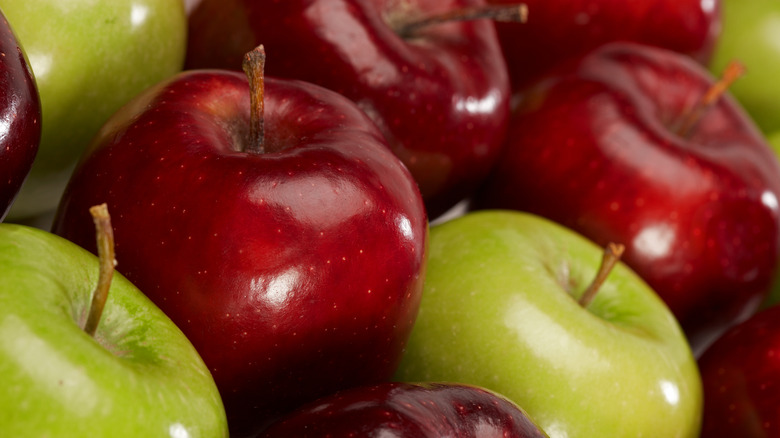Those Beautiful Oranges At The Grocery Store May Just Be Dyed
When you're shopping for produce at the grocery store, you might be inclined to reach for the brightest, glossiest fruits and veggies of the bunch. But make no mistake — those vibrantly hued pyramids of apples, avocados, limes, and other bounties are probably treated with an artificial wax coating or dye. The lustrous oranges beckoning for you to choose them over their organic counterparts are no exception.
Adding shine to make food look more enticing is nothing new. Way back in the first century AD, the Roman gastronome Apicius wrote that "an expensive silver platter would enhance the appearance of this dish materially." And as The Atlantic reminded us back in 2017, food purveyors have been zhuzhing up and preserving their products for over 900 years. In ancient Japan, for instance, people used a soy-milk reduction called yuba to protect their food in storage.
As for the suspiciously perfect-looking oranges at your local supermarket, they've likely been doused in a layer of Citrus Red 2. The artificial dye makes them look even more, well, orange. Luckily, dye-treated citrus is nothing to fret over; it's what's behind the peel that counts.
Don't overindulge on the peels
Before you go throwing out your latest haul of shiny oranges from the store, rest assured that the Citrus Red 2 used to dye those orange rinds is unlikely to make it into the fruit itself. The dye, which has been approved by the FDA for orange-coloring purposes since 1952, is allegedly safe as long as it's not being directly ingested on a regular basis. According to the National Library of Medicine, the dye only poses a "possibly carcinogenic" risk to humans if it's consumed often. However, both California and Arizona have banned the dye.
Yahoo! encourages shoppers to choose organic oranges if they regularly consume orange zest or candied orange peels at home (though a single use of a dyed peel shouldn't do any harm). "Most people are eating the inside of citrus, and the benefits of what's inside outweigh the residual dye on the exterior," the publication claims.
What to do about wax
It's easy to peel the dyed skin off an orange, but that's not the case for all beautified fruits at the grocery store. If you see a Red Delicious apple so shiny you could check your teeth in it, chances are it's been sprayed with a layer of a food-grade coating called carnauba wax. Though it's been the subject of public concern for decades, some claim it isn't harmful, while others warn against the digestive issues can cause. That said, it's easy to remove if you prefer a more natural, organic look.
The simplest method involves dropping your wax-coated apples in hot water for just a few seconds. Don't worry, it won't cook the fruit. Once you fish it out, run it under the faucet and rub away the wax with a towel, or gently scrub it with the coarse bristles of a vegetable brush. Even if you don't mind consuming carnauba wax, it's a fun experiment to see what a coated apple looks like with its sheen removed.


